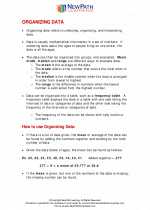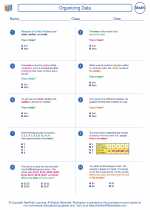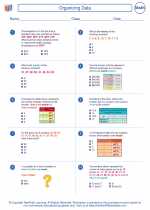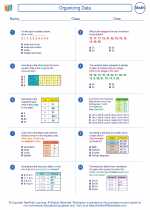Organizing Data -> real-world problems
Real-World Problems
Explanation
Real-world problems in mathematics involve using mathematical concepts to solve problems that occur in everyday life. These problems require students to apply their knowledge of various mathematical operations, such as addition, subtraction, multiplication, and division, to solve real-life situations.Real-world problems can be found in various scenarios, including shopping, cooking, budgeting, and measurement. By solving these problems, students can understand the practical application of mathematical concepts and develop critical thinking and problem-solving skills.To solve real-world problems, students need to read the problem carefully, identify the mathematical operations or concepts involved, and use appropriate strategies to find the solution. It's essential for students to translate the given information into mathematical expressions or equations and then solve them to find the answer.Study Guide
1. Read Carefully
When encountering a real-world problem, read the problem statement carefully to understand the context and what is being asked.2. Identify the Operations
Identify the mathematical operations or concepts involved in the problem, such as addition, subtraction, multiplication, division, or fractions.3. Formulate Equations
Translate the given information into mathematical expressions or equations. Use variables to represent unknown quantities if necessary.4. Solve the Equations
Use appropriate strategies to solve the equations or mathematical expressions. This may involve performing the necessary operations and simplifying the expressions.5. Check Your Answer
After finding the solution, double-check your answer to ensure it makes sense in the context of the real-world problem. Does the answer align with the given information and the question asked?6. Practice, Practice, Practice
.◂Math Worksheets and Study Guides Seventh Grade. Organizing Data
Study Guide Organizing Data
Organizing Data  Worksheet/Answer key
Worksheet/Answer key Organizing Data
Organizing Data  Worksheet/Answer key
Worksheet/Answer key Organizing Data
Organizing Data  Worksheet/Answer key
Worksheet/Answer key Organizing Data
Organizing Data 

 Worksheet/Answer key
Worksheet/Answer key
 Worksheet/Answer key
Worksheet/Answer key
 Worksheet/Answer key
Worksheet/Answer key

The resources above cover the following skills:
Data Analysis and Probability (NCTM)
Select and use appropriate statistical methods to analyze data.
Find, use, and interpret measures of center and spread, including mean and interquartile range.